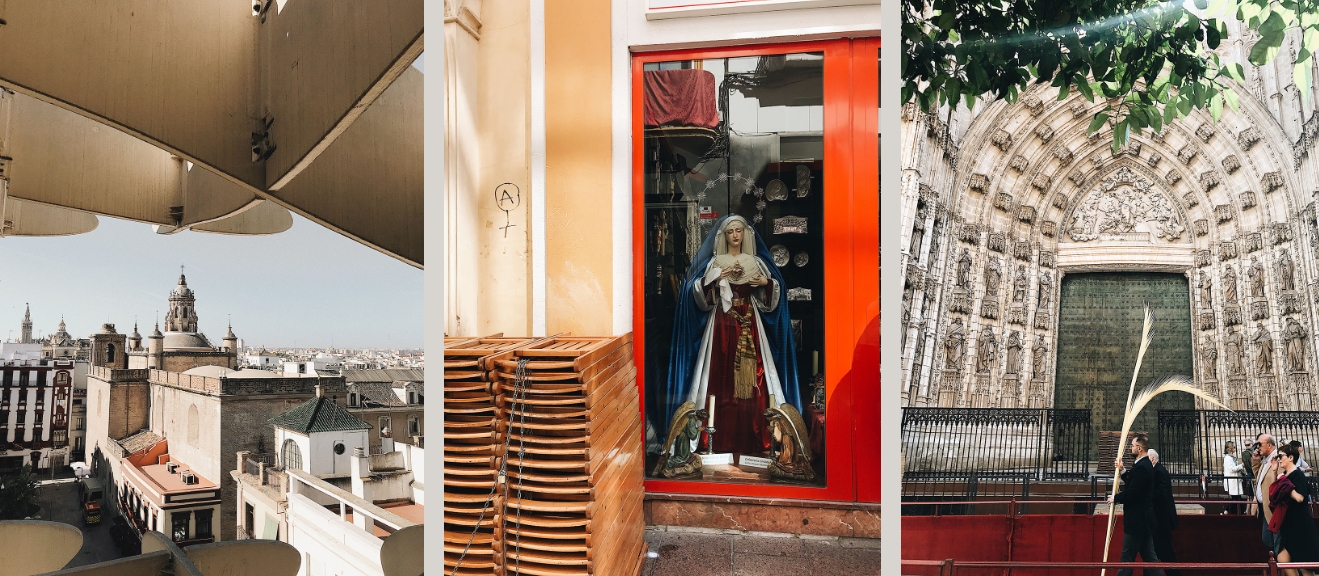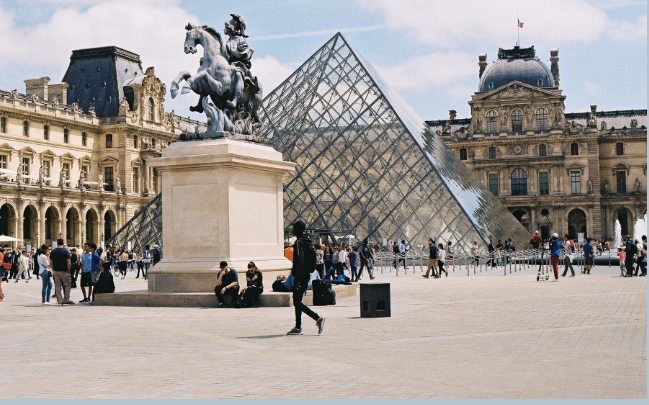Altafulla
This resort town immediately attracted our attention. You can get here in 50 minutes by train from Barcelona from the Sants station, and since there is a railway station in the city, you can also actively visit other cities. To Tarragona – 8 minutes by train, to Reus – 25, and we also wanted to include these places in our route. Blue flags on the beach are evidence of their cleanliness, grooming, environmental friendliness and accessibility. There is something to see – both sights and natural places.
Altafulla meets with an abundance of greenery and bright colors – cypresses, pine trees, oleanders, bougainvilleas. The city is filled with pleasant sounds – shouts of doves, twitter of swallows, chirping of forty. But seagulls fly over the sea completely silently and measuredly. Like a lot of what is happening in this place.
There are not many tourists here, mainly the Catalans themselves. The coastline is a little over a kilometer. The first thing that catches your eye is gold in the sand. They are especially noticeable in the sunlit outgoing breaking wave. A delightful sight.
Golden sand, blue sea, white fishing houses on the promenade (the waterfront area of Botigues de Mar), a medieval castle, local products, aromas of coniferous trees and alluring smells from restaurants – there is nothing superfluous, only something that can cause a feeling of carelessness and bliss. You can just swim, admire the sand, collect pebbles, walk along the beach, as most local vacationers do. You can chill in the shadows cast by the castle and the pine forest with a book in your hands. There is a marine club for water sports right on the beach.
Go on one or more of the seven walking or cycling trails offered in the travel booklets. They are with the idea: “Go to lose yourself. Go to find yourself. ” On your way you can meet an olive tree that is more than 600 years old, a forest of white pines, the mouth of the Gaia River – a natural wildlife sanctuary, traditional shepherd’s huts built from sandstone slabs without the use of any cementing material. There is a Roman quarry. Its special microclimate promotes the growth of plant species unusual for this territory.
Altafulla is a city with a history. The first mention dates back to the 11th century. Medieval architecture, surrounded by walls in the upper part of the city, is well preserved, therefore the old city has the status of a historical and architectural reserve. A leisurely walk through the medieval streets gives surprises at every corner and around every turn – unusual angles and even secrets.
Not far from the old town is the Ethnographic Museum (Museu d’Altafulla) . It was created by enthusiasts – collectors who certainly love their job. Admission is free, it works on weekends (on Saturday from 18.00 to 20.00 and on Sunday from 11.00 to 14.00). In a relatively small area, collections of everything are collected: old tools, equipment, utensils, toys. The way this is all masterfully organized in space deserves attention.
Ancient Roman Villa “Els Munts” (Passeig Forti) . In the lower part of the city on a small hill there is an open-air archaeological museum – the remains of the ancient Roman villa “Els Mounts”. It was built in the 1st century A.D. Similar villas were quite widespread in the Roman Empire. At first, these settlements were mainly engaged in agriculture, but gradually in Roman society, among the rich population, the idea of an isolated life in the countryside arose. And therefore, every year more and more villas acquired the status of suburban residences. As part of the archaeological complex of Tarraco (Tarraco), the villa is a UNESCO World Heritage Site. Excavations have been carried out since 1967 and continue to this day. If you are lucky – you can watch them.
In the museum you can get an idea of how Roman buildings were planned, how the terms looked – the most famous inventions of that time. The owners of the villa held high administrative posts in ancient Tarraco – the so-called then capital of the Roman province of Near Spain. This is evidenced by the statues found during excavations, road and wall coverings, mosaics and marble columns. Some of the materials are in the National Archaeological Museum of Tarragona.
The museum has recreated a small garden with local cultures. The museum is somewhat aloof from other buildings, so nothing will distract you from a deep immersion in history.
Castle is built, surrounded by ramparts. It was first mentioned in the 11th century, when it defended the city from Ottoman Turks and from pirates. Since the 20th century it has been privately owned – it can be rented for special occasions. The castle stands almost among the waves. You can make only a small climb up the hill on one side. However, if you really want to, you can get around the castle by plunging into the sea.
Calm and measured life in the town in the summer is violated by traditional holidays and festivals. We were lucky to visit two of them – the Night of San Joan and the Night of the Witches.
From June 23 to 24, the main summer holiday, the Night of San Joan , is celebrated in Catalonia . The tradition originated in pre-Christian times and is associated with the celebration of the summer solstice. On this day, it is customary to light bonfires and arrange fiery performances. The scope with which locals fire fireworks this night is impressive.
On the last weekend of June, the local festival of the Witch’s Night takes place in Altaful. Medieval traditions come to life, filling the city with mysticism. There is a legend that in the Middle Ages, when there was an active witch hunt, the locals came up with instead of executing to drive all the suspicious people out of the city gates. Over the years, a tradition arose in the theatrical performance of “casting out” witches. These days fortunetellers, sorcerers and practicing witches gather in the city, offering their services to festival participants. You can read the tarot, draw a prediction, visit the esoteric fair or artisan shops and buy amulets, charms, healing minerals and herbs, frankincense, and miraculous creams. The performance is organized closer to midnight and ends with a ceremony of seeing off San Joan. A shaman walks around all the participants in a clay pot spectacle.
The next day, you can watch the procession of giants. Cat, Old and Young Witches, Sorcerer and Sorceress – these are his main characters. And, of course, it cannot do without the fire show traditional for Catalonia.
You can get gastronomic pleasure in restaurants (there are more than 30 of them) offering local cuisine using local products. As a rule, lunch in the restaurants of Catalonia lasts from 13.00 to 16.00. And they begin to feed dinner after 19.00, and if the chef was late, then after 20.00.
Tarragona
The city is only 15 kilometers from Altafulla. Here you will face the story. The city is positioning itself this way – “Tarragona: a living history”. The ruins of the basilica and the Roman street, the amphitheater, the Roman walls in the Forum square, the arch, the arch and the walls in the Palol square – quite a lot of monuments of ancient Roman architecture have survived. All this is adjacent to more modern buildings and even residential buildings. Residential and museum spaces are visually practically combined. A very strong sense of historical continuity is created.
There are medieval buildings – of incredible size. A cathedral with an interesting museum, a medieval market, Gothic arches in the Jewish quarter. You can look into one of the mansions of the New Time. For example, in the Canals Family Manor ( Casa Canals , Carrer Granada, 11) – wander through its luxurious interiors, look at the city from a window or from a terrace, as the owners themselves once did. Tickets cost € 3.30.
Tarragona is a port city, one of the important marine centers of Spain. On its territory are a marina for yachts, cruise, fishing and cargo ports. The most spectacular view of the port opens from the observation deck “Balcony of the Mediterranean” on the Rambla Nova (Rambla Nova) . The port is interesting to take a walk.
You can catch the spirit of marine life in the fishing quarter of El Serrallo , in the immediate vicinity of the port. Boats, an old church, a square, unusual fountains with scenes from port life, numerous restaurants. Locals support the uniqueness and originality of the area. They are proud of their work, and the houses of the area are decorated with inspirational posters depicting occupations traditional for this place.
Castellar School is located in El Serrallo. It is easy to notice from the drawing at the end of the building. The tradition of building towers from people – castels – originates in the region of Tarragona from the end of the 18th century. The participants in the process strive to build the highest structure with the highest number of levels. The tradition is very revered in the city. Walking along the Rambla Nova, pay attention to the bronze composition of the authorship of the Catalan sculptor Francesc Angles. It displays the process of building a tower at its climax. Among more than 200 participants – Pablo Picasso, Pablo Casals, Joan Miro.
We accidentally got on the Festival Castel on the area of Sant Magi (the Sant of Magi) . We saw the performance of several teams. We felt that this was not just a contest in strength and dexterity. Unity, team spirit, support (literally “shoulder feeling”), confidence in the people who are nearby – this is what you can penetrate, observing from the side.
Maritime Museum (Moll de Costa) . Located in the port in the premises of a former warehouse built in the middle of the 20th century. This space is an ideal place for such a museum in terms of both size and location. The exposition of the museum helps to make a journey into history from the moment of the Roman conquest of the territory to the present day. The main thematic areas are commercial activities of the port, fishing and marine sports. Among the objects – ships, port equipment, goods, lighthouses – everything that displays typical life on the docks. Free admission.
In Tarragona it is worth visiting the Central Market (placa Corsini, 9) to buy fresh seasonal products, admire the very construction made in the style of “Catalan modernism”, as well as the beauty and well-groomed interior space.
Tarragona is multifaceted and incomparable. To understand it, it is better to plan an acquaintance in several stages. Fortunately, from a logistic point of view, this is very simple.


